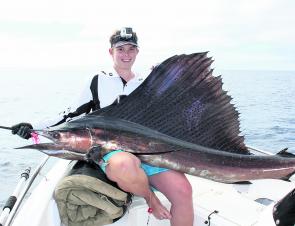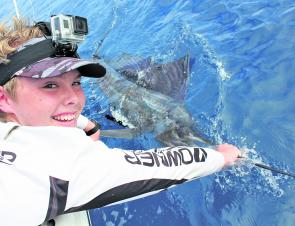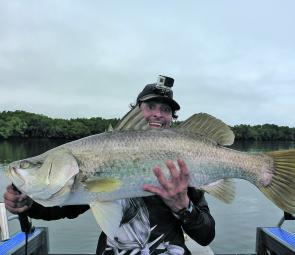The light game fishing has been hot when the weather has allowed boats to get offshore and October should offer more opportunities to head east.
The waters will be warming rapidly and coral trout should spawn in the lead up to the new moon on the 24 October.
The warmer water temperature will also see the estuaries fire up, with barra, jacks and golden snapper getting into the action. Here’s hoping October produces its usual awesome weather and fishing.
The first of two coral reef fish closures for 2014 occurs on 21-25 October, so keep this in mind when planning your reef fishing this month. Trout will be up shallow this month, so work areas of bommies in the 20-30m depth range.
Large mouth nannygai will be around in quality, if not quantity, in the deep water.
There will also be reef jacks, spangled emperor and the odd red emperor to add variety to the catch.
Cobia will be around this month, so don’t cut off what seems to be a shark at first sight, until you have had a close up inspection. Speaking of sharks, they were horrendous this time last year and their over-abundance so far this year indicates they will be just as bad this time round.
A floater out the back will put you in with a chance of nailing a Spanish mackerel, which will still be around, though not usually that thick. All up the reef should be productive when Huey grants access.
Other pelagics will be turning it on for the dedicated light and heavy tackle anglers. If the start of the light tackle season is any indication, anglers are in for some hot action. As well as Spaniards, there will be northern bluefin tuna, yellowfin tuna, wahoo, small black marlin and the early big blacks to keep the sports fishermen on their toes. The first of the really big blacks will be starting to turn up on the Continental Shelf and the marinas will be abuzz with stories and excitement in anticipation of a great heavy tackle season this year.
Closer inshore, around the wrecks, reefs and islands there should still be a few late season school mackerel, the odd Spaniard and a few northern bluefin tuna to keep the popper, slice and minnow tossers and trollers occupied.
Estuary anglers will be turning their focus to nailing a barra as the water warms. They will be active from the upper reaches to the headlands and it will mainly be the weather that dictates the best location to fish. If the winds are calm and the weather warm, make a beeline for the headlands, by foot or sea. Focus your efforts around dawn and dusk and the tide changes, with lures and live baits. Luring from the rocks and live baiting from the boat is a pretty sound approach.
When the winds blow, the estuaries are the go, with the better barra hanging around the river and creek mouths. Look for the closest snag to the mouth of a river, creek or drain and work it with lures or feed in a live bait as the current slackens around the tide change.
Many lure tossers make the mistake of not getting deep enough into a snag when luring and deep enough works both ways. The lure needs to be as far into the snag as you can land it and you need to get it deep in the water. This immediately puts sinking lures at a big advantage when peppering the snags. A floating lure will still work but are best in shallow water. By the time you crank a floater down deep enough it is often away from where the fish are sitting.
Imitation prawns or soft plastics, rigged with a weedless jig head, are perfect for this approach. Practice your casting so you can consistently land the lure in the same spot and gradually allow it to sink further each cast until you are getting right to the bottom under the snag. Often the biggest and best fish are sitting right at the base of a snag and need to be teased into action.
The same approach works for mangrove jack and the heavier the timber the better. If a snag looks so thick that it seems near impossible to pull a fish out of it, then it is the ideal place to nail a red devil.
Start landing the lure on the outer edges of the snag and gradually work it deeper as you find your range and confidence. If you are a little more accurate with your casting, get that lure right to the base of the snag first cast and hang on!
Golden snapper will also be getting in on the action in the deeper water in the estuaries, Cairns Inlet and along the headlands.
Jigging, casting and trolling deep diving lures will all produce the goods with this prized and difficult to catch fish. Sardines, mud herring, mullet, prawns and squid are all proven live baits for nailing this trophy of trophy fish.
Bait soakers will find plenty to keep them entertained, with grunter, mangrove jack, juvenile trevally and queenfish all willing to take a well-presented dead bait. Grunter, queenfish and trevally will tend to bite best towards the mouth of a system on the last of the rising tide, while I have always preferred the falling tide for jacks.
A good outing is to fish the flats and gutters near the mouth, on the rising tide and the first of the run out, then move upstream and fish the mangrove edges for jacks as the water drains out of the mangroves with the receding tide. Jacks tend to push too far up into the mangroves feeding with the rising tide but will often patrol the mangrove edge on the falling tide, waiting for bait to come back out of the timber with the receding water.
October offers a myriad of fishing options and it is a great month to do some serious angling before the heat and the rain restricts your opportunities.
Reads: 1212
Ryan Tivey caught this magnificent sailfish during a great day light tackle fishing off Cairns with his father Andrew

Ryan was stoked to swim the fish back to life and watch it power away.

Anglers will be hoping to tangle with a trophy barra like this one caught by Justin Thaggard in Cairns Inlet earlier this year.




